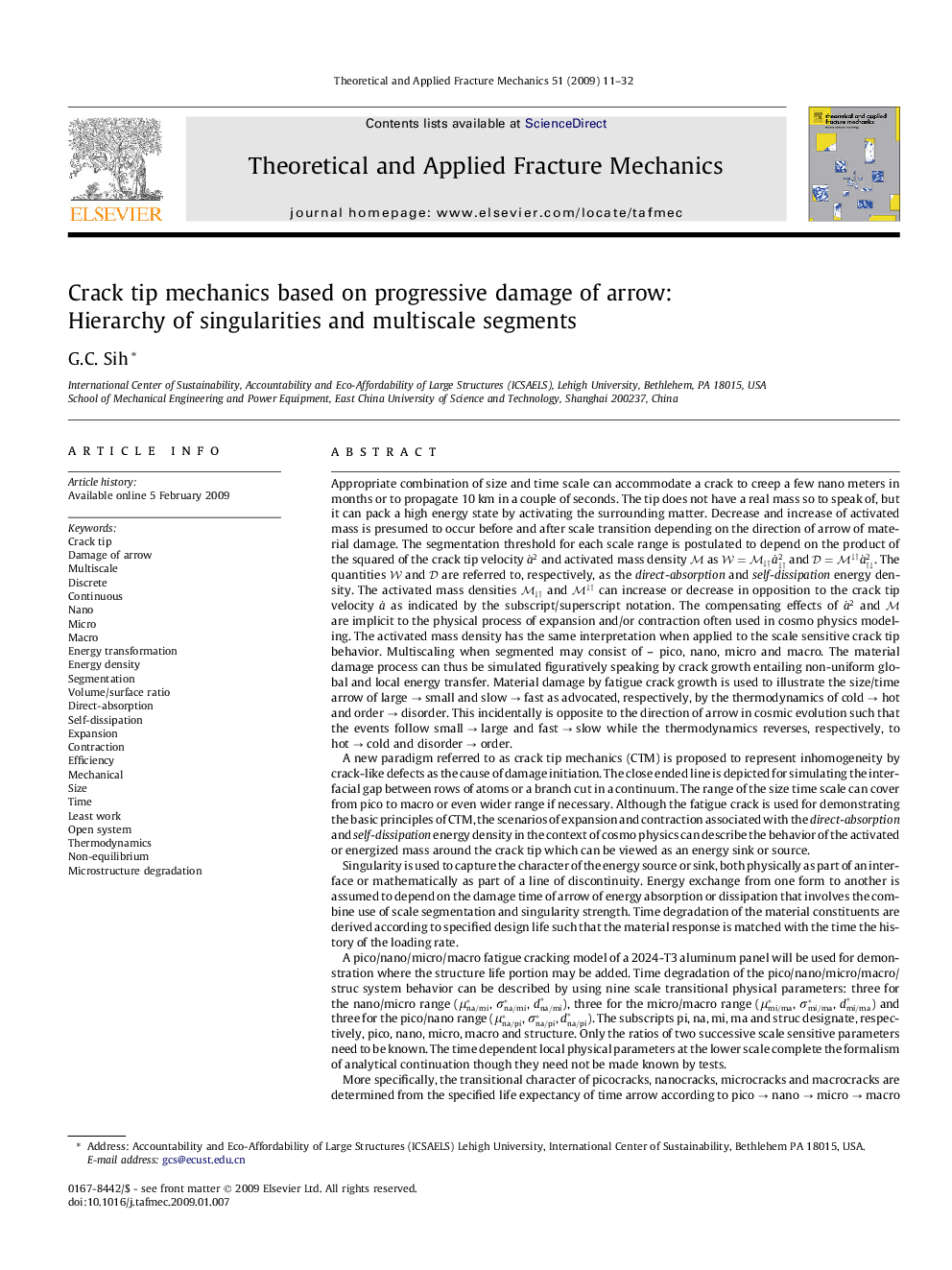| کد مقاله | کد نشریه | سال انتشار | مقاله انگلیسی | نسخه تمام متن |
|---|---|---|---|---|
| 804997 | 905037 | 2009 | 22 صفحه PDF | دانلود رایگان |

Appropriate combination of size and time scale can accommodate a crack to creep a few nano meters in months or to propagate 10 km in a couple of seconds. The tip does not have a real mass so to speak of, but it can pack a high energy state by activating the surrounding matter. Decrease and increase of activated mass is presumed to occur before and after scale transition depending on the direction of arrow of material damage. The segmentation threshold for each scale range is postulated to depend on the product of the squared of the crack tip velocity a˙2 and activated mass density MM as W=M↓↑a˙↓↑2 and D=M↓↑a˙↑↓2. The quantities WW and DD are referred to, respectively, as the direct-absorption and self-dissipation energy density. The activated mass densities M↓↑M↓↑ and M↓↑M↓↑ can increase or decrease in opposition to the crack tip velocity a˙ as indicated by the subscript/superscript notation. The compensating effects of a˙2 and MM are implicit to the physical process of expansion and/or contraction often used in cosmo physics modeling. The activated mass density has the same interpretation when applied to the scale sensitive crack tip behavior. Multiscaling when segmented may consist of – pico, nano, micro and macro. The material damage process can thus be simulated figuratively speaking by crack growth entailing non-uniform global and local energy transfer. Material damage by fatigue crack growth is used to illustrate the size/time arrow of large → small and slow → fast as advocated, respectively, by the thermodynamics of cold → hot and order → disorder. This incidentally is opposite to the direction of arrow in cosmic evolution such that the events follow small → large and fast → slow while the thermodynamics reverses, respectively, to hot → cold and disorder → order.A new paradigm referred to as crack tip mechanics (CTM) is proposed to represent inhomogeneity by crack-like defects as the cause of damage initiation. The close ended line is depicted for simulating the interfacial gap between rows of atoms or a branch cut in a continuum. The range of the size time scale can cover from pico to macro or even wider range if necessary. Although the fatigue crack is used for demonstrating the basic principles of CTM, the scenarios of expansion and contraction associated with the direct-absorption and self-dissipation energy density in the context of cosmo physics can describe the behavior of the activated or energized mass around the crack tip which can be viewed as an energy sink or source.Singularity is used to capture the character of the energy source or sink, both physically as part of an interface or mathematically as part of a line of discontinuity. Energy exchange from one form to another is assumed to depend on the damage time of arrow of energy absorption or dissipation that involves the combine use of scale segmentation and singularity strength. Time degradation of the material constituents are derived according to specified design life such that the material response is matched with the time the history of the loading rate.A pico/nano/micro/macro fatigue cracking model of a 2024-T3 aluminum panel will be used for demonstration where the structure life portion may be added. Time degradation of the pico/nano/micro/macro/struc system behavior can be described by using nine scale transitional physical parameters: three for the nano/micro range (μna/mi∗,σna/mi∗, dna/mi∗), three for the micro/macro range (μmi/ma∗, σmi/ma∗, dmi/ma∗) and three for the pico/nano range (μna/pi∗, σna/pi∗, dna/pi∗). The subscripts pi, na, mi, ma and struc designate, respectively, pico, nano, micro, macro and structure. Only the ratios of two successive scale sensitive parameters need to be known. The time dependent local physical parameters at the lower scale complete the formalism of analytical continuation though they need not be made known by tests.More specifically, the transitional character of picocracks, nanocracks, microcracks and macrocracks are determined from the specified life expectancy of time arrow according to pico → nano → micro → macro with the respective singularity strength of λ given by 1.25/1.00/0.75/0.50. An additional singularity of strength 0.25 may be added for the structural components. Recall that λ = 0.5 corresponds to the inverse square root r−0.5 in fracture mechanics with r being the distance from the macrocrack tip. The microcrack, nanocrack and picocrack tip are assigned with the singularities r−0.75, r−1.00 and r−1.25, respectively. The time of arrow in years will depend on the problem definition. A critical device component may be designed to operate at the pico/nano/micro/macro scale with a life distribution of 1.5±/2.5±/3.5±/5.5± and total life of 13± years. The superscript ± indicates more or less the actual time elapsed. Progressive damage is assumed to occur in the direction of pico → nano → micro → macro. The same scheme is applied to the fatigue damage of a 2024-T3 panel with a total life time of 20 years that may be distributed over the pico, nano, micro, macro and struc scale according to 1.5±/2.5±/3.5±/5.5±/7.0±. Such a specification can only be satisfied by matching the energy used in damaging the internal material structure at each scale range. Hence, the precise time dependent material property degradation process over the total life span can be enforced.
Journal: Theoretical and Applied Fracture Mechanics - Volume 51, Issue 1, February 2009, Pages 11–32